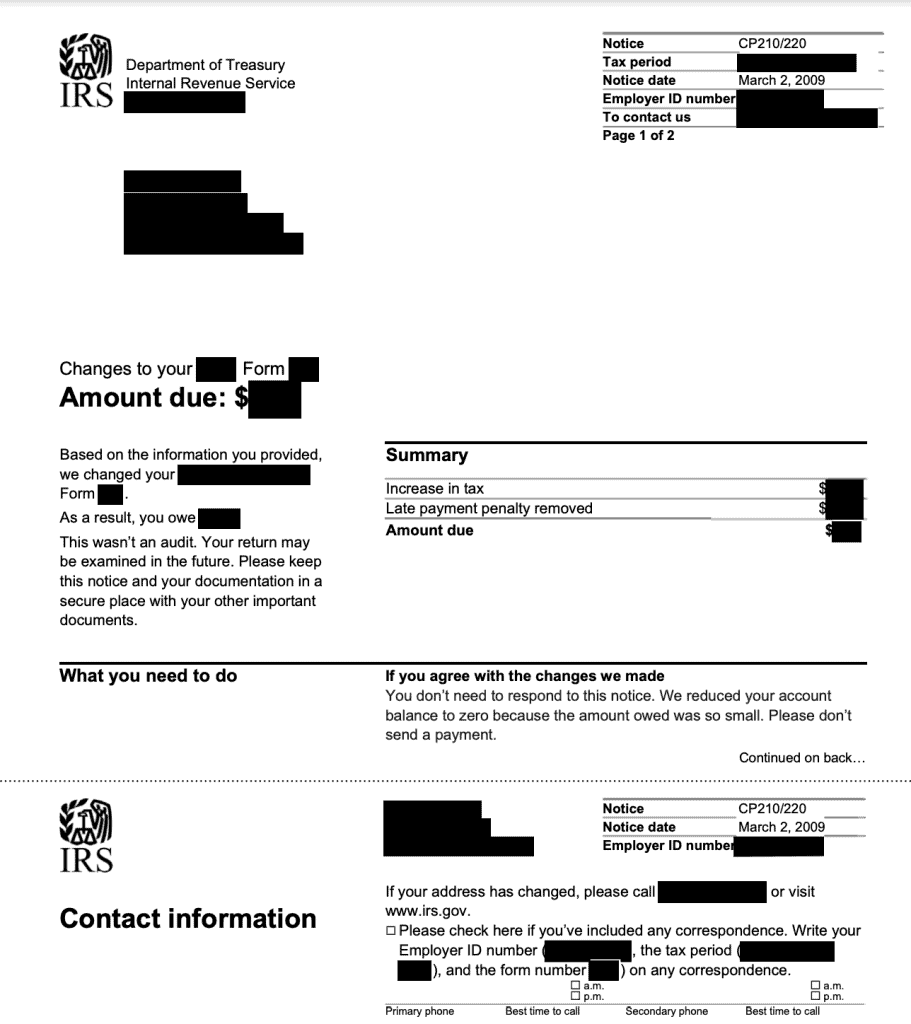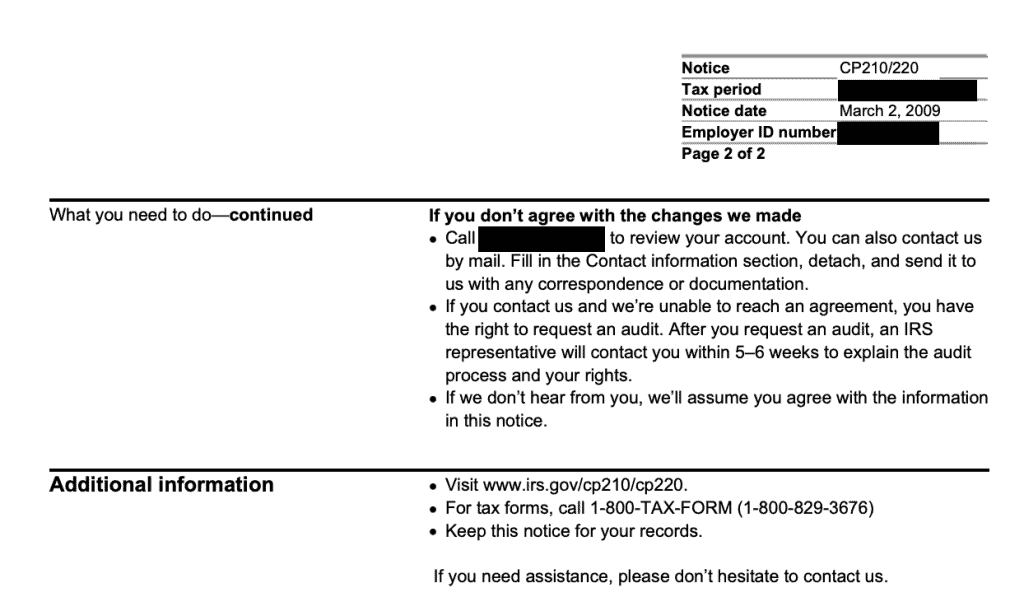
Level Up Your Business Today
Join the thousands of people like you already growing their businesses and knowledge with our team of experts. We deliver timely updates, interesting insights, and exclusive promos to your inbox.
Join For FreeIRS Notice CP210/220 informs taxpayers of changes made to tax returns. Here's what to expect when you receive this IRS notice in your mailbox.

If you received a CP210/220 notice in the mail, don’t panic. The IRS sends notices for a variety of reasons, not just because there is an error. So, what does this particular notice mean?
Here’s everything you need to know about why the IRS sent you a CP210/220 notice, what you need to do about it, and what this notice means for your taxes.
Table of Contents

Source: IRS, screenshot taken 10/24/2023
The IRS sends notices to taxpayers when there is a tax return error, to request a payment, to request additional information, or to notify you about a change.
The CP210/CP220 notice is sent by the IRS when there is a change to your tax return. These changes always pertain to the tax year listed on the notice. These changes include:
Often, this notice indicates that a balance is owed to the IRS, but if you’ve recently filed for the employee retention credit, you may receive a positive sum amount on this notice to let you know what the total of your ERC credit will be.
To find out why you received a CP210/220 notice and what caused your tax return to change, you’ll need to carefully read the details included in the notice.
The IRS sends CP210/CP220 notices when:
When I faced a tax audit in the past, I received a CP210/220 after the IRS received additional paperwork to let me know that I no longer owed a balance. The CP210/220 isn’t always a negative and can sometimes bring welcomed news about changes to your tax return, such as a resolved balance or an ERC credit your business is due.
No matter why you receive a CP210/220, always make sure you save your IRS notice for your personal record-keeping, especially if additional action is needed. You can still be audited after receiving an IRS Notice CP210/220, so it’s important to keep records of all notices and proceedings with the IRS.

Source: Internal Revenue Service (IRS), screenshot taken 10/24/2023
Some action may be required when you receive a CP210/220 notice from the IRS, but the action taken depends on exactly which changes were made and whether you agree with the changes.
You’ll see in the image of an actual CP210/CP220 above that “if we [the IRS] don’t hear from you, we’ll assume you agree with the information in this notice.”
You have one of two options when you receive this notice:
If you disagree with the IRS’s changes, you can call the number on your tax notice and speak to the IRS directly or contact your accountant or tax preparer. We highly recommend seeking professional advice before dealing with the IRS, especially if your tax preparer offers audit protection.
Once you speak to the IRS or your tax professional, you may need to:
Note: If your CP210/220 indicates that the IRS owes you money, the IRS states, “you should receive a refund check in 4-6 weeks” (potentially sooner if the IRS has your direct deposit information on file).
The IRS can audit taxpayers for all tax returns over the last five years (or even longer if substantial errors are identified), so it’s safe to assume that CP210/CP220 notices can also be sent during this timeframe.
A CP210/CP220 notice does not always indicate an audit. It’s just letting you know that a change has been made, but an audit can still happen after you receive this notice, even if you agree with it.
In my personal experience, I was audited two years after the related tax return and told I owed a balance to the IRS. Once the audit was settled and I no longer owed a balance, I received a CP210/220. In this case, I received a CP210/220 notice two years after the corresponding tax year.
Once a taxpayer claims the employee retention credit, eligibility is verified, and the credit is approved, the IRS will send a CP210/220 notice letting the employer know the official amount of the tax credit.
There’s also a possibility that the IRS may send a CP210/220 if they need additional information to confirm your eligibility.
If you need more help understanding your IRS notices or want extra peace of mind when it comes to your tax return, don’t be afraid to seek professional help from a CPA, Enrolled Agent, or certified tax preparer. Check out our post on ghost tax preparers for more information on sifting a scammy tax preparer from a great one.
Get in touch with a real human being on the Merchant Maverick team! Send us your questions, comments, reviews, or other feedback. We read every message and will respond if you'd like us to.
Reach OutGet in touch with a real human being on the Merchant Maverick team! Send us your questions, comments, reviews, or other feedback. We read every message and will respond if you'd like us to.
Reach Out
Let us know how well the content on this page solved your problem today. All feedback, positive or negative, helps us to improve the way we help small businesses.
Give Feedback
Want to help shape the future of the Merchant Maverick website? Join our testing and survey community!
By providing feedback on how we can improve, you can earn gift cards and get early access to new features.
Help us to improve by providing some feedback on your experience today.
The vendors that appear on this list were chosen by subject matter experts on the basis of product quality, wide usage and availability, and positive reputation.
Merchant Maverick’s ratings are editorial in nature, and are not aggregated from user reviews. Each staff reviewer at Merchant Maverick is a subject matter expert with experience researching, testing, and evaluating small business software and services. The rating of this company or service is based on the author’s expert opinion and analysis of the product, and assessed and seconded by another subject matter expert on staff before publication. Merchant Maverick’s ratings are not influenced by affiliate partnerships.
Our unbiased reviews and content are supported in part by affiliate partnerships, and we adhere to strict guidelines to preserve editorial integrity. The editorial content on this page is not provided by any of the companies mentioned and has not been reviewed, approved or otherwise endorsed by any of these entities. Opinions expressed here are author’s alone.